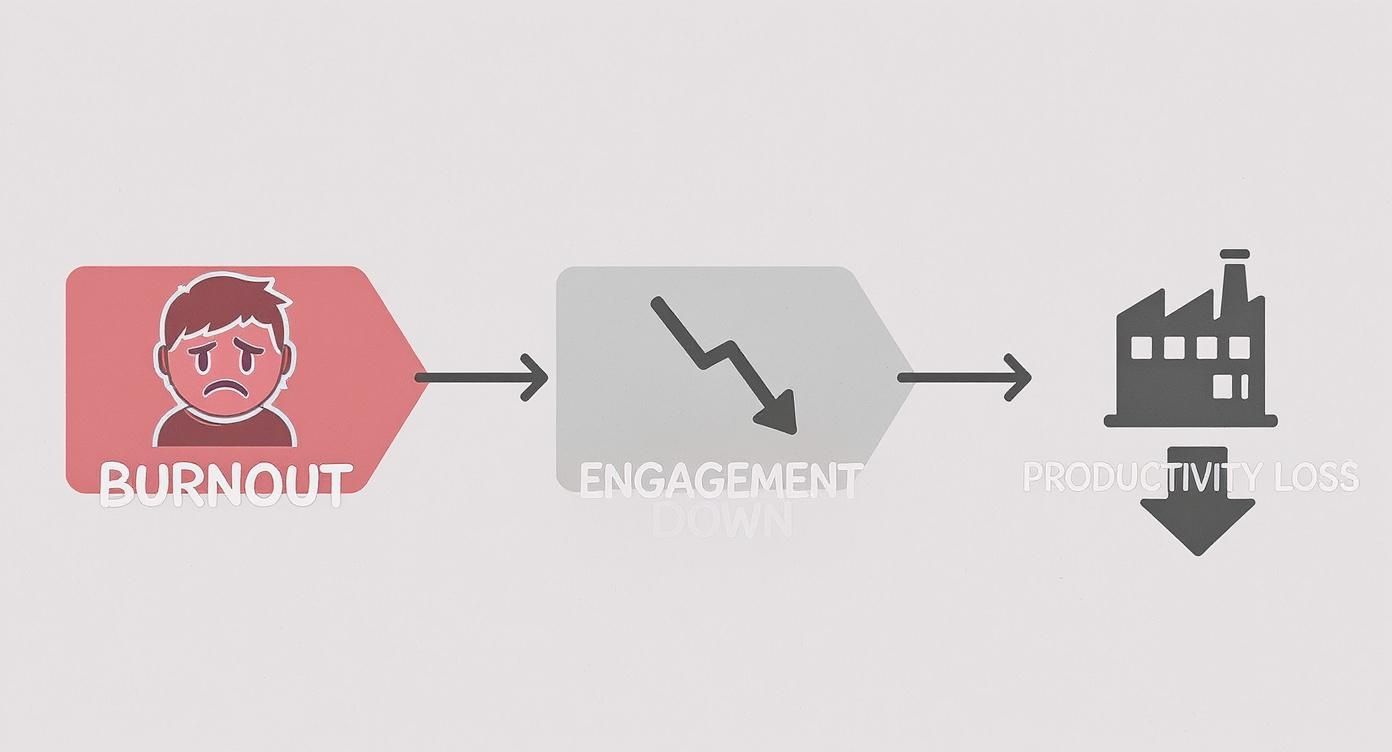Improving workplace culture isn't about adding a new coffee machine or a ping-pong table. It's about a revolutionary commitment to creating an environment built on psychological safety, open communication, and genuine recognition.
When you get this right, you don't just build a company—you build a community. A place where people feel valued, heard, and connected to a shared mission. That energy is what sparks unstoppable engagement and innovation.
Why Your Workplace Culture Is a Business Imperative
Let's be honest. Soaring burnout rates and plummeting engagement aren't just HR buzzwords; they're critical business risks. A neglected culture quietly erodes productivity, suffocates creativity, and pushes your best people toward the exit.
Transforming your culture isn't just an investment; it's the single most powerful strategy for long-term success.
A positive environment doesn't just make people happier; it makes the business stronger. When employees feel trusted and respected, they become your most passionate advocates. According to a Gallup study, businesses with highly engaged teams see 21% greater profitability. This connection is the engine that drives not only morale but also customer loyalty and your bottom line.
The True Cost of a Disconnected Team
The financial impact of a poor culture is staggering. Globally, employee engagement has dropped to a mere 23%, costing the world economy an astounding $8.8 trillion in lost productivity.
On the flip side, the potential gain is incredible. Research shows that improving workplace wellbeing could boost the global economy by trillions. You can find out more about these workplace culture statistics and see the numbers for yourself.
This visual shows the domino effect perfectly—how a declining culture starts with burnout and spirals into major productivity losses.

The story here is urgent: when people feel drained, their connection to work fades, directly impacting business outcomes. This isn't just a people problem; it's a performance problem.
The health of your culture is the leading indicator of your future success. A thriving team isn’t a byproduct of success—it’s the cause.
Investing in your people is a direct investment in your company's resilience and capacity for growth. The question is no longer if you can afford to focus on culture, but whether you can afford not to.
Build a Foundation of Psychological Safety
Forget the surface-level perks for a moment. A truly great culture is built on something far more powerful: trust. At its core, an inspiring workplace stands on a foundation of psychological safety.
Coined by Harvard Business School professor Amy Edmondson, this is the shared belief that it's safe to take interpersonal risks. It’s the freedom to speak up, ask a "silly" question, or challenge an old process—all without fear of being shut down or shamed.
Imagine the difference. In one office, an employee spots a flaw in a project but stays silent, fearing they’ll look negative. In another, that same person raises their concern openly, sparking a crucial conversation that saves the project weeks of wasted effort. That second scenario only happens when psychological safety is the norm.
This feeling of security is a powerful performance driver. A 2017 Gallup study found that just three in ten U.S. workers strongly agree that their opinions seem to count at work. Boosting that ratio to six in ten could realize a 27% reduction in turnover and a 40% reduction in safety incidents. You can discover more insights about workplace attitudes to see the gap.
Action Points: Fostering a Fearless Environment
Building this environment starts with leadership modeling the right behaviors. The goal is to shift the team's mindset from a fear of failure to a passion for learning.
- Model Vulnerability: A leader who openly admits a mistake or says, "I don't have the answer," gives everyone permission to be human.
- Frame Work as Learning: Position new projects as experiments, not tests. This encourages curiosity and bold ideas.
- Actively Seek Dissent: In meetings, ask, "What are we missing?" or "What's a potential problem with this?" This signals that constructive disagreement is essential.
Psychological safety isn’t about being nice. It's about giving candid feedback, openly admitting mistakes, and learning from each other in order to achieve excellence. It's the key to unlocking a team's collective intelligence.
You can also use next-level corporate team building activities to foster deeper connections. When people feel secure, they bring their best, most authentic selves to work, and innovation becomes your default state.
Fuel Connection Through Better Communication
Misunderstandings, unclear expectations, and siloed teams can silently poison a company’s atmosphere. The solution isn't just to "communicate more"—it's about redesigning how information and feedback flow through your organization.
Think of communication as the lifeblood of an inspired team. When done right, it builds trust, reinforces your mission, and ensures every single person feels heard, valued, and clear on their role in the bigger picture.

Action Points: Energize Your Meetings
We've all been in meetings that drain our will to live. Transform them into powerful points of connection with intentional structure.
- Define a Clear "Why": Every meeting invitation must state a clear purpose and desired outcome. No purpose? No meeting.
- Rotate Facilitators: Let different team members lead discussions. This builds leadership skills and ensures diverse voices are heard.
- End with Action: Every meeting should end with a recap of decisions and clearly assigned action items to maintain momentum.
An intentional meeting structure respects everyone's time and energy. It sends a powerful cultural message: our time together is valuable, and we are here to make meaningful progress.
Action Points: Practice Radical Transparency
Trust is built when people feel they're in the loop. While you can't share everything, being transparent about the "why" behind decisions helps employees feel like valued partners. This means sharing challenges alongside successes and creating safe channels for upward feedback. Open communication is key, even for distributed teams—explore these team building activities for remote workers to keep connections strong.
Action Points: Implement Structured Feedback
Annual reviews are outdated. A culture of continuous improvement thrives on regular, constructive feedback that flows in all directions.
Actionable Communication Strategies
| Strategy | Problem It Solves | Implementation Example |
|---|---|---|
| "Start, Stop, Continue" | Makes feedback less intimidating and more routine. | In one-on-ones, ask team members for one thing a colleague should "start," "stop," and "continue" doing. |
| Open Office Hours | Breaks down leadership silos and encourages dialogue. | A leader blocks off one hour a week for anyone to drop in (virtually or in-person) with questions or ideas. |
| Project "Retrospectives" | Creates a safe space to learn from experience. | After a project, the team discusses: "What went well?" and "What would we do differently next time?" No blame allowed. |
By normalizing feedback with simple frameworks, you create an environment where everyone is invested in each other's success.
Design Recognition That Genuinely Motivates
Does your recognition program actually make an impact? Many fall flat because they feel generic. To build a culture people love, you need a system where employees feel truly seen for their specific contributions.
The secret isn't a bigger budget. A study by OC Tanner revealed that 79% of employees who quit their jobs cite "lack of appreciation" as a key reason. Recognition that resonates goes deeper than bonuses; it's about acknowledging effort and celebrating behaviors that reflect your core values.

Action Points: Go Beyond the Annual Bonus
Motivation thrives on frequent, timely feedback. When recognition becomes an ongoing conversation, you reinforce positive behaviors in real-time and keep morale high all year long. This creates a powerful feedback loop where people who feel consistently appreciated are more engaged, loyal, and connected to the company's mission.
Action Points: Make Appreciation Specific and Public
Vague praise like "good job" lacks impact. Motivating recognition connects a person's action directly to a company value.
- Peer-to-Peer Slack Channel: Create a #kudos channel where anyone can publicly thank a colleague. Encourage specifics like, "Huge thanks to Sarah for staying late to help me troubleshoot that client issue—you really embodied our 'customer first' value!"
- Team Meeting Shout-Outs: Start every team meeting by celebrating wins. A manager could say, "I want to recognize David for his incredible problem-solving on the Q3 report. His attention to detail saved us from a major error."
When you celebrate someone for how they achieved something, not just what they achieved, you're not just recognizing an individual—you're teaching your entire team what success looks like in your culture.
Action Points: Empower Everyone to Give Recognition
Recognition shouldn't just flow from the top down. Empowering peers to celebrate each other creates a far more connected and supportive environment. This fosters a sense of collective ownership over the culture.
Ultimately, recognition is the currency of a great culture. It's the small, consistent acts of appreciation that send a clear message: "Your work matters, and you are valued here."
Champion Wellbeing to Prevent Burnout
For too long, wellness has been a checklist item—a gym membership or a yoga class. These perks don't get to the heart of what prevents burnout.
Employee wellbeing is the foundation of a high-performing culture. It's time to move beyond surface-level fixes and weave genuine wellbeing into your company's DNA. This means creating an environment where people can manage their energy, not just their time.
When you prioritize your team's mental and emotional health, you unlock creativity, focus, and a deeper level of engagement.
Action Points: Move from Perks to Proactive Support
Real wellness is built into the way you work. It's about tackling root causes of stress, like constant notifications and back-to-back meetings. The goal is a workday that allows for both deep focus and genuine disconnection.
- Introduce "Focus Time" Blocks: Encourage everyone to block out no-meeting periods in their calendars. This gives them permission to do the deep, uninterrupted work crucial for productivity and mental clarity.
- Normalize Mental Health Days: Treat mental health with the same respect as physical health. When leaders openly take time to recharge, it removes stigma and shows wellbeing is a true priority.
- Offer Real Flexibility: Trust your team to adapt their workday to fit their lives. This empowers them to bring their best selves to work.
A culture of wellbeing is built on proactive, systemic support, not reactive perks. It’s about creating conditions where employees can thrive, rather than just offering them tools to cope with an unsustainable pace.
Action Points: Make Mental Health Resources Accessible
Providing easy, stigma-free access to mental health support is non-negotiable. With 76% of employees experiencing burnout at least sometimes, investing in accessible resources is a direct investment in your company's future.
Actively promote resources like confidential counseling services and stress-management workshops. For more ideas, our guide on mental health support in the workplace offers actionable steps. When asking for help is seen as a sign of strength, you build a safety net that protects your most valuable asset: your people.
Measure and Sustain Your Cultural Momentum
Building a great workplace culture isn't a one-time project. It’s a living system that needs constant attention. How do you ensure the positive seeds you've planted continue to grow?
The secret is to measure what matters. A great culture is shaped by genuinely listening to your team. Simple tools can offer a powerful snapshot of your company’s health, creating a gentle, ongoing feedback loop.

Action Points: Tune In to Your Team's Voice
Gathering honest feedback keeps the momentum going. Instead of waiting for an annual survey, use lighter-touch methods to understand how your team is really feeling.
- Anonymous Pulse Surveys: These short, frequent check-ins ask just a few key questions, helping you spot small issues before they become big problems.
- 'Stay Interviews': Unlike exit interviews, these chats focus on what makes your best people stay. Ask questions like, "What’s something you look forward to when you come to work?" to uncover what you're doing right.
The goal isn’t to chase a perfect score, but to open a genuine dialogue. When employees see their feedback leads to real action, they become invested partners in building a better culture.
This consistent listening creates a powerful cycle of improvement. There are more great tips and strategies for measuring employee satisfaction that can help you track progress. Combining human feedback with metrics like your Employee Net Promoter Score (eNPS) and turnover rates gives you a clear, data-backed view of your progress.
Your Top Workplace Culture Questions, Answered
Taking the first step to improve your company’s culture is a courageous act. Here are answers to common questions leaders ask on this journey.
How Long Until We See Real Change?
You’ll feel small, positive shifts in morale within weeks—more collaboration, more energy. But deep, lasting cultural transformation is a marathon, not a sprint.
Expect to see measurable changes in behaviors and key metrics like engagement in about 6 to 18 months. The secret is celebrating small wins along the way to build momentum.
What’s the Single Most Impactful Thing a Leader Can Do?
Simple: model the behavior you want to see. Your actions will always speak louder than a mission statement on a wall.
If you want a culture of trust, be the first to admit a mistake. If you want open communication, put your phone down and listen intently. Leading by example is the catalyst for real change.
"A culture of respect is priceless and far more impactful than any expensive benefit. Many of the most powerful drivers of a great culture cost nothing—they are about changing behaviors, not buying perks."
Can We Actually Improve Our Culture on a Tight Budget?
Absolutely. This is one of the biggest myths holding companies back. Some of the most powerful elements of a thriving culture are completely free.
Building psychological safety, giving specific recognition, and practicing transparent communication are about behavior. They require commitment and intention, not a big budget. A vibrant culture is within reach for any organization willing to do the work.
At Mesmos, we believe in creating environments where people feel valued and inspired. Our collections of thoughtful gifts and stationery are designed to foster connection and mindfulness in every aspect of life. Discover meaningful ways to appreciate your team at mesmos.co.
